Call Center Work From Home Model
The call center (also known as the contact center) industry is starting to determine if their current work from home model is sustainable post-COVID-19. A Gallup poll showed that two-thirds of employees would like to continue working remotely for employees who have transitioned to the work from home (WFH) model because of COVID-19.
Furthermore, a recent Gartner poll found that 48% of employees will likely continue to work from home at least part-time after COVID-19. And a J.D. Power poll showed that 86% of 124 customer service organizations they studied plan to implement a permanent WFH model after COVID-19 passes.
As a result of the COVID-19 pandemic, most SQM call center clients decided to have their agent and support staff WFH. Furthermore, our 2021 call center employee research shows that 87% of agents are currently working from home. Conversely, in 2019, 19% of agents worked from home. As most call center practitioners know, it was a sudden and drastic shift to a WFH model. This article focuses on whether or not the current agent WFH high percentage is here to stay.
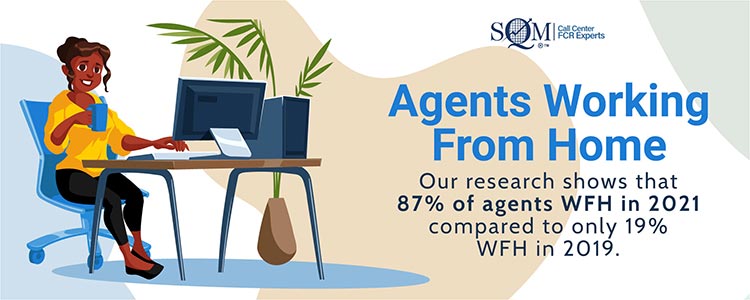
As most people know, companies have transitioned agents to a WFH model for their safety and to ensure they can provide customer service at the same level, or better, than before the COVID-19 pandemic. As a result, SQM Group conducted a study of 500 leading North American call centers to determine the impact of pre/post-COVID-19 by assessing operational, employee, and customer experience data.
The call center WFH model could be viewed as a business disruption with many benefits and challenging factors to consider. The factors can differ by industry, line of business, culture, geography, technology, security risk, and telecommunication infrastructure. For example, if the telecommunication bandwidth is low for many agents, it will negatively impact their productivity and operating costs. The below graph highlights the benefits and challenges of the call center WFH model.
CALL CENTER BENEFITS AND CHALLENGES OF THE WFH MODEL
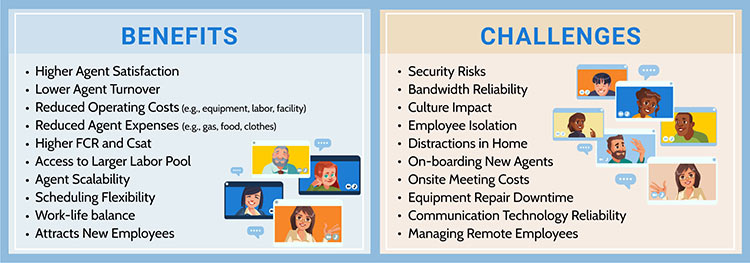
Call Centers are Planning for their Workforce Location Model
Many organizations have either determined or are thinking about the agent workforce model that they want to use post-COVID-19. However, we have very few clients that have moved back to a traditional 100% call center facility-based workforce location model. That is not to say that at some point, more organizations will move back to call center facility-based model, however not in the near future. We are more confident that the WFH model is here to stay. The current 87% of agents working from home among our client base is likely to decrease long-term.
In addition, the hybrid model is picking up momentum for most organizations but more so for professional service jobs (e.g., managers, IT, HR). However, in most cases, the workforce location model for agents and supervisors is either WFH or call center facility-based but not the hybrid model. For example, most call centers do not have agents working three days at home and two days at their call center facility to handle customer interactions. Put differently, in the majority of the cases, agents either work 100% in a WFH or call center model, but not both.
However, our experience is that agents and supervisors who work remotely go to the call center location for meetings, coaching, training, and recognition events. In addition, after two years of operating in a COVID-19 pandemic, most call centers have struggled to transition their past practices (e.g., meetings, coaching, training) to support a fully WFH model. Therefore, WFH agents go to the call center to fulfill those business practices. Some clients have successfully transitioned to a WFH model using more virtual business practices (e.g., onboarding, learning, training, hiring).
There are many benefits (e.g., higher agent Csat and Esat, lower turnover, scalability, and work-life balance) with the WFH model. These benefits can be categorized at either the agent, the call center, or organization levels. As a result, many organizations have discovered that the WFH model effectively delivers higher employee and customer satisfaction while reducing operating costs.
Most call center leaders now believe that the WFH model has been one of the great unintentional positive outcomes of the COVID-19 pandemic. Due to higher employee and customer satisfaction with reduced operating costs, most call center leaders will continue with a WFH model.
SQM's predicts that the call center industry's post-COVID-19 workforce model will be 60%-80% agents WFH, and 20%-40% agents work in a call center facility-based model. Our agent workforce allocation forecast is based on the fact that agents prefer WFH. As a result, organizations will be forced to have a WFH model to attract new agents, especially when considering the current competitive labor market.
Put simply, the labor market is forcing organizations to offer the WFH model, and those who do not will find increasing challenges in attracting new agents. While there are many benefits to the WFH model, there are also many challenges. These challenges can also be categorized at the agent, call center, and organization levels.
Some call centers have successfully overcome the WFH challenges more than others. Organizations with higher customer and employee satisfaction have been better at transitioning their people, process, and technology practices to support their WFH delivery model.
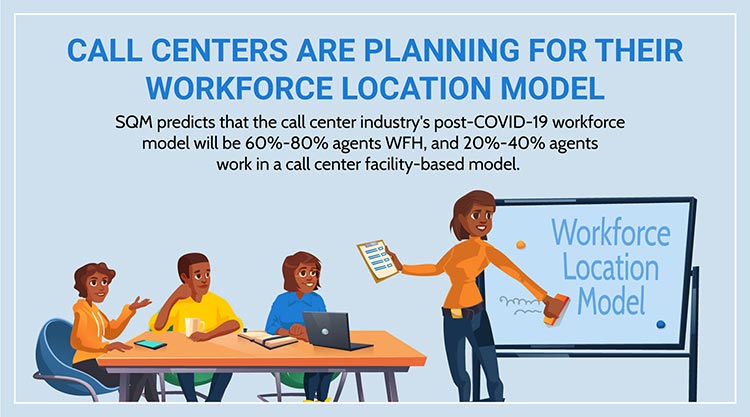
WFH Impact on Call Center Customer Satisfaction
The question we get asked the most is what has been the impact of COVID-19 on call centers using a WFH model on customer service? To answer that question, we have benchmarked over 500 leading North American call centers' customer satisfaction (Csat) by comparing pre-COVID-19 (2019) to post COVID-19 (2020/2021) performance.
When we compared 2020 to 2019 Csat top box rating response (e.g., very satisfied) for call centers, the breakdown was 26% declined, 20% stayed the same, and 55% improved. And, when we compared 2021 to 2019 Csat rating for call centers, the breakdown was 36% declined, 14% stayed the same, and 49% improved.
Given that in 2020, 75% of call centers' Csat rating stayed the same or improved, and in 2021, 63% of call centers' Csat rating stayed the same or improved, it would suggest that the WFH model is conducive for achieving high customer service. Therefore, there is a strong business case for the WFH model as the primary call center workforce operating practice to service customers.
However, in 2021, 10% more call centers' Csat rating declined than in 2020 compared to pre-COVID-19 Csat rating (2019) for the call center industry. SQM believes that the Csat decline in 2021 is primarily due to agent turnover and the highly competitive labor market.
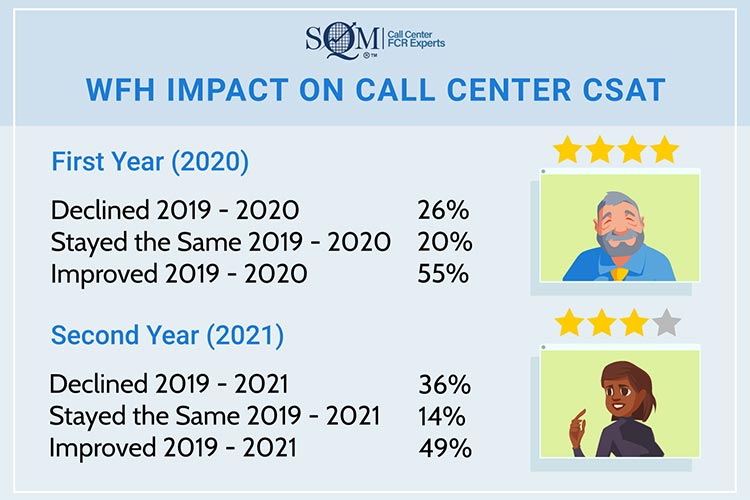
We assessed key performance indicators such as calls transferred, average handle time, agent turnover, agents working remotely, and inbound call volume to gain more insights into call centers' customer satisfaction performance.

Calls Transferred
SQM's research shows that 19% of customers who phone a call center are transferred to another agent. Moreover, our research indicates that Csat (top box response rating) is 12% lower when a customer call is transferred to another agent. When we compared 2021 to 2019 calls transferred for call centers, the breakdown was 38% went up, 6% stayed the same, and 55% went down. In 2021, the call transfer rate went up for 10% of call centers from 2020. Agent turnover issues drove the increase in calls transferred to another agent.
SQM believes that having more calls transferred is one of the primary reasons why more call centers' Csat declined in 2021. The increase in calls transferred is primarily driven by a labor shortage and high agent turnover. A higher proportion of agents have less tenure and less knowledge, skills, and abilities to resolve calls. An organization's call center is no longer competing for agents in their local marketplace; they compete for agents against call centers anywhere in the country. WFH agents now have many more choices of where they can work, which has been good for agents but challenging for call centers to attract new agents.
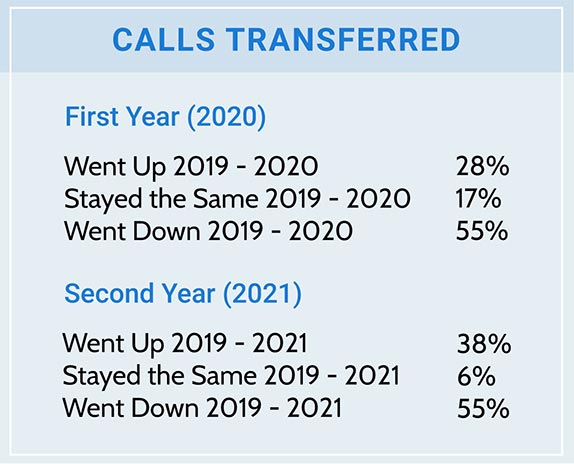

Average Handle Time
We compared 2021 to 2019 for average handle time (AHT), in 2019 AHT was 545 seconds and in 2021 AHT was 589 seconds, which resulted in an 8% increase. The increase in AHT is partly due to easier calls handled by self-service contact channels such as IVR and website. However, SQM's view of the higher AHT (talk time + wrap-up time) is primarily due to high agent turnover. A higher proportion of agents have less tenure and less knowledge, skills, and abilities to resolve calls. As a result, the new agents have driven lower Csat and higher AHT. In addition, keeping up to date with the constantly changing government guidelines and mandates has also negatively impacted AHT.
In 2021, call center call volume only decreased by 4% from 2019. Furthermore, 71% of call centers experienced a decline in call volume. Conversely, 29% of call centers experienced an increase in call volume. Put differently, even though the call volume average has seen a modest decrease, there has been significant call volume variation among call centers.
SQM’s research shows that for every 1% improvement in First Call Resolution (FCR), there is a 1% improvement in customer satisfaction. Furthermore, the FCR rate is impacted by call length. Our research shows the FCR rate goes down the longer the call length. For example, the FCR rate for the 1 to 3-minute call length is 76% versus the 15-minute call length, where the FCR rate is 62%. Most call lengths are between 5 to 10 minutes for the call center industry. For those call lengths, the FCR rate is 70%.


Agent Turnover
Even though agent satisfaction is higher for WFH than for the call center facility-based model, agent turnover drastically increased in 2021. When we compared 2021 to 2020 for agent turnover, there has been a 46% increase. The high agent turnover is due to a labor shortage. As a result, call centers compete for agents in the local marketplace and nationally. In 2021, agent turnover drove lower Csat, and higher AHT and operating costs for the call center industry.
SQM's research has shown that call centers' FCR performance can substantially decrease due to high agent turnover resulting in increased operating costs. For example, if a call center handles one million calls annually and has 100% annual agent turnover (which is not uncommon), the decrease in FCR could increase the call volume by 10%. The 10% increase in call volume would result in 100,000 additional calls. With an average cost per call of $8.60 for a typical call center, 100,000 more calls would compute to $860,000 in additional operating costs.
In 2021, the agent turnover rate of 35% is the highest turnover percentage we have ever measured in over 25 years of benchmarking this metric. Furthermore, agent turnover is the biggest issue hindering call centers in terms of cost and customer service. Therefore, to ensure the sustainable WFH model, the call center needs to improve agent turnover. SQM's view is that agent turnover is the number one challenge facing call center industry leaders.
So the question now becomes, how can a call center fix the high agent turnover rates? This question is really important, especially considering the huge labor shortages that the call center industry is facing. As a result of the labor shortages, it is common for agents to job-hop to another organization’s call center based on better pay and incentives.
Implementing a VoC Performance Management System has been one of the quickest ways to improve FCR, Csat, and Esat. It has also been the most consistent best practice for improving FCR and for helping retain agents. Another essential step for coping with agent labor shortages is implementing an employee VoC reward and recognition program and ensuring agent career development opportunities. These practices have been very effective for both attracting and retaining agents.


Agents Working From Home
We compared 2021 to 2019 for agents working from home, in 2019 19% of agent WFH and in 2021 87% of agents WFH, which resulted in a 350% increase. It is impressive that our client call centers have increased the percentage of agents working from home significantly while also, in most cases providing the same or improved Csat. Furthermore, 78% of agents had the same or higher job satisfaction than they had when working in their call center pre-COVID-19. Most agents working from home appreciate the work-life balance that the WFH model provides (e.g., spending less time commuting to work and having more time available to spend with their family and friends).
Given that for most call centers that use the WFH model, their Csat, Esat, FCR, and costs metrics stayed the same or improved, it is very likely the WFH model is here to stay. As a result, many organizations will continue to have the WFH model as the primary method for handling customer calls after COVID-19 subsides. SQM clients tell us that for servicing their customers after COVID-19 subsides, the WFH model will continue to be at the 80% level or higher, with many using a 100% WFH approach.

Quick Related Links
First Call Resolution PPT First Call Resolution Benefits Agent Coaching First Call Resolution Operating Philosophy Call Handling First Call Resolution Improvement Tips VoC Performance Management Agent Recognition QA Form Customer Quality Assurance Customer Satisfaction Customer Service Management Software Free Software Demo

